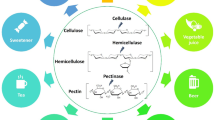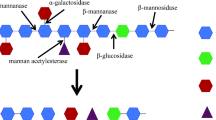Abstract
Microorganisms that colonize plants require a number of hydrolytic enzymes to help degrade the cell wall. The maize endophyte Acremonium zeae was surveyed for production of extracellular enzymes that hydrolyze cellulose and hemicellulose. The most prominent enzyme activity in cell-free culture medium from A. zeae NRRL 6415 was xylanase, with a specific activity of 60 U/mg from cultures grown on crude corn fiber. Zymogram analysis following SDS-PAGE indicated six functional xylanase polypeptides of the following masses: 51, 44, 34, 29, 23, and 20 kDa. Xylosidase (0.39 U/mg), arabinofuranosidase (1.2 U/mg), endoglucanase (2.3 U/mg), cellobiohydrolase (1.3 U/mg), and β-glucosidase (0.85 U/mg) activities were also detected. Although apparently possessing a full complement of hemicellulolytic activities, cell-free culture supernatants prepared from A. zeae required an exogenously added xylosidase to release more than 90% of the xylose and 80% of the arabinose from corn cob and wheat arabinoxylans. The hydrolytic enzymes from A. zeae may be suitable for application in the bioconversion of lignocellulosic biomass into fermentable sugars.

Similar content being viewed by others
References
Adelsberger H, Hertel C, Glawischnig E, Zverlov VV, Schwarz WH (2004) Enzyme system of Clostridium stercorarium for hydrolysis of arabinoxylan: reconstitution of the in vivo system from recombinant enzymes. Microbiology 150:2257–2266
Bischoff KM, Rooney AP, Li X, Liu S, Hughes SR (2006) Purification and characterization of a family 5 endoglucanase from a moderately thermophilic strain of Bacillus licheniformis. Biotechnol Lett 28:1761–1765
Fisher PJ, Petrini O, Lappin-Scott HM (1992) The distribution of some fungal and bacterial endophytes in maize (Zea mays L.). New Phytol 122:299–305
Grohmann K, Bothast RJ (1997) Saccharification of corn fibre by combined treatment with dilute sulphuric acid and enzymes. Process Biochem 32:405–415
Harris MR (1936) The relationship of Cephalosporium acremonium to the black-bundle disease of corn. Phytopathology 26:965–980
Ikeda Y, Hayashi H, Okuda N, Park EY (2007) Efficient cellulase production by the filamentous fungus Acremonium cellulolyticus. Biotechnol Prog 23:333–338
Jordan DB (2008) β-d-Xylosidase from Selenomonas ruminantium: catalyzed reactions with natural and artificial substrates. Appl Biochem Biotechnol 146:137–149
King SB (1981) Time of infections of maize kernels by Fusarium moniliforme and Cephalosporium acremonium. Phytophathology 71:796–799
Leathers TD, Gupta SC (1996) Saccharification of corn fiber using enzymes from Aureobasidium sp. strain NRRL Y-2311-1. Appl Biochem Biotechnol 59:337–347
Mitsuishi Y, Takashi Y, Yagaisawa M, Takasaki Y (1987) Purification and properties of thermostable xylanases from mesophilic fungus strain Y-94. Agr Biol Chem 51:3207–3213
Reddy CS, Holbert JR (1924) The black-bundle disease of corn. J Agr Res 27:177–206
Saha BC, Bothast RJ (1999) Pretreatment and enzymatic saccharification of corn fiber. Appl Biochem Biotechnol 76:65–77
Saha BC, Bothast RJ (2000) Enzymes in biotechnology. In: Lederberg J (ed) Encyclopedia of microbiology, vol 2. Academic Press, San Diego, CA, pp 222–235
Sorensen HR, Pedersen S, Meyer AS (2006) Optimization of reaction conditions for enzymatic viscosity reduction and hydrolysis of wheat arabinoxylan in an industrial ethanol fermentation residue. Biotechnol Prog 22:505–513
Sorensen HR, Pedersen S, Vikso-Nielsen A, Meyer AS (2005) Efficiencies of designed enzyme combinations in releasing arabinose and xylose from wheat arabinoxylan in an industrial ethanol fermentation residue. Enzyme Microb Technol 36:773–784
Sumner DR (1968) Ecology of corn stalk rot in Nebraska. Phytopathology 58:761–765
Suto M, Takebayashi M, Saito K, Tanaka M, Yokota A, Tomita F (2002) Endophytes as producers of xylanase. J Biosci Bioeng 93:88–90
Wicklow DT, Roth S, Deyrup ST, Gloer JB (2005) A protective endophyte of maize: Acremonium zeae antibiotics inhibitory to Aspergillus flavus and Fusarium verticillioides. Mycol Res 109:610–618
Wong KKY, Tan LUL, Saddler JN (1988) Multiplicity of β-1,4-xylanase in microorganisms: functions and applications. Microbiol Rev 52:305–317
Yamanobe T, Mitsuishi Y, Takasaki Y (1987) Isolation of a cellulolytic enzyme producing microorganism, culture conditions and some properties of the enzymes. Agr Biol Chem 51:65–74
Yamanobe T, Mitsuishi Y, Takasaki Y (1985) Method for manufacture of cellulase. U.S. Patent 4562150
Acknowledgment
The authors wish to thank Eric Hoecker, Jay Braker, Imran Khan, and Jacob Brown for technical assistance.
Author information
Authors and Affiliations
Corresponding author
Additional information
Mention of a trade name or commercial products in this publication is solely for the purpose of providing specific information and does not imply recommendation or endorsement by the U.S. Department of Agriculture.
Rights and permissions
About this article
Cite this article
Bischoff, K.M., Wicklow, D.T., Jordan, D.B. et al. Extracellular Hemicellulolytic Enzymes from the Maize Endophyte Acremonium zeae . Curr Microbiol 58, 499–503 (2009). https://doi.org/10.1007/s00284-008-9353-z
Received:
Revised:
Accepted:
Published:
Issue Date:
DOI: https://doi.org/10.1007/s00284-008-9353-z




